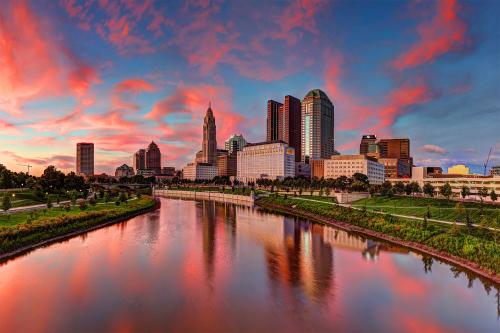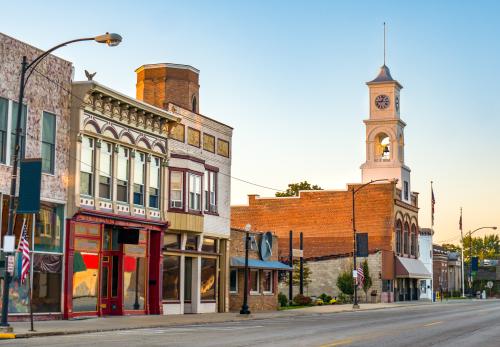A key challenge for many Rust Belt communities, large and small, revolves around how they can evolve their economies from reliance on low-skill factory jobs and paternal company town employers (many now long gone), to more diverse and dynamic entrepreneurial economies. Many analysts assert that the struggles of these older industrial communities help explain their political “flip” from blue to red in 2016, contributing to Donald Trump’s deciding margin in the Electoral College.
As previous posts (see here and here) in this series explored, the Rust Belt is neither an economic nor a cultural monolith. A number of the region’s larger city-regions have successfully shed their single-industry monikers and realities. No longer is Minneapolis the Flour City, Pittsburgh the Steel City, or Cincinnati “Porkopolis” (a nod to its history as a slaughterhouse community).
The picture looks a bit different from the perspective of small and midsized Rust Belt communities, at a time when economic activity seems to be consolidating in the supercities of the nation and world. What combination of leveraging existing assets—leading universities, waterfront locations, forward-looking companies, unique history or culture—and innovative economic development strategy has enabled some of these places to transition more successfully and shed their old Rust Belt image? How much do communities owe their economic destiny to historical legacies versus purposeful agency?
Universities matter
One economic engine for the revival of both large and small Rust Belt communities, as Noah Smith recently observed, is the presence of research universities and colleges. A recent Brookings analysis of changes in median household income over the last 15 years shows the big winners were largely the nation’s coastal metropolitan supernovas and extractive industry boom towns. The only fast-growing non-extractive industry “boomtowns” in the Midwest/Rust Belt region were Morgantown, W. Va. (home to West Virginia University), State College, Pa. (home to Penn State), and Blacksburg, Va. (home to Virginia Tech).

The presence of higher education facilities has a positive impact on the relatively few places across the industrial Midwest with above-average incomes today. Fewer than one in six counties in the Rust Belt swing states of Wisconsin, Michigan, Indiana, Ohio, and Pennsylvania (63 of 402) have per capita incomes higher than their statewide averages (see Table 1). The University of Wisconsin, University of Michigan, Notre Dame University, Indiana University, Ohio State University, Carnegie Mellon University, and University of Pittsburgh (among many other institutions) are clearly big contributors to the high incomes that characterize their home counties. (Communities with significant university hubs are marked in white on the table.)

Metro size matters, too
Consistent with national patterns, most Rust Belt economic “winners” are also the larger metros of the region, where a more diverse, innovation-driven economy is concentrated, aided by presence of the top-tier universities. Of the high-income counties in these key swing states, many are suburbs in the bigger regional economies around Chicago, Cleveland, Columbus, Detroit, Indianapolis, Louisville, Milwaukee, Minneapolis, Pittsburgh, and Philadelphia. (Major metro suburban counties are marked in blue in Table 1; Posey and Warrick counties in Indiana are suburbs of Evansville, a regional education, health care, and trading center.)
But what about those high-income communities that aren’t home to a major university nor part of a bigger metropolitan region (marked in “rust” on Table 1)? What did the “winning” communities have, or what did they do, that might offer guidance for the rest? Four categories of places stand out:
1. Smart economic developers
A number of mid-sized markets are benefiting from long-term public/private investment in local innovation, human capital, and quality of place:
· Grand Rapids (Kent County, Michigan) utilized purposeful strategy to grow health-medical complexes and become an environmentally sustainable community leader, with moves to repopulate downtown with arts, culture, higher education institutions, and a reworked riverfront. Now market forces are taking over with new offices, apartments, and entertainment developments are mushrooming.
· In Summit County, Ohio, home to historic tire and rubber town Akron, a revitalized downtown with mixed-use developments, arts, museums, convention centers and stadiums has breathed new life to the core city; public-private-university partnerships have supported the location and growth of employers in emerging technology, manufacturing, and polymer/plastics sectors; and new transportation and logistics hubs leverage Akron’s location as a major transportation crossroads.
· In Kalamazoo, Michigan, a multi-faceted economic development strategy kept top talent when pharma giants Upjohn and Pfizer closed their doors by helping scientists start new, smaller biotech firms; remade a newly walkable downtown with entertainment, arts, and craft beer; and extended free public higher education to all high school graduates through the Kalamazoo Promise, marking the community as a talent magnet and reversing trends of urban exodus.
· Green Bay in Brown County, Wisconsin may be seeing the economic payoff from purposeful work to redevelop a downtown district and waterfront, expand the University of Wisconsin-Green Bay’s footprint including a new Engineering School and partnerships with current and start-up businesses; and leveraging (in order to keep in town) the iconic Green Bay Packers’ brand and role in the community including a new Packers-Microsoft Tech Incubator development adjacent to legendary Lambeau Field.
2. Continuously innovating company towns
Some smaller counties have benefited from the presence of specialized multinational companies or industry clusters that retain a strong commitment to their places.
· In Columbus (Bartholomew County, Indiana), a longstanding commitment to innovation by its “company town” employer Cummins, Inc., first marked the community as a showcase of forward-leaning architecture and community design (as Cummins bankrolled the best architects in the world to design new buildings), while Cummins itself stayed at the fore of corporate innovation—a continuous leader in clean technology.
· Similarly, Midland County, Michigan is anchored by Dow Corporation (now merged with DuPont), a company that has stayed on the cutting edge of industrial innovation serving global markets; and sprinkled arts, culture, and lifestyle amenities (including helping rebrand the area as the Great Lakes Bay Region) in order to keep and attract top talent.
· In Warsaw, Indiana (Kosciusko County), industrial innovators found a niche in fast-growing medical devices manufacturing, and the community is now home to a cluster of firms that design and make one-third of the nation’s orthopedic products.
· Jasper in Dubois County, Indiana is one of the more prosperous small-town community regions in the nation, where clusters of manufacturers of home and office furnishings, auto, and electrical equipment have stayed competitive.
3. Building on place and history
Other higher-income counties ring the beautiful Great Lakes shoreline, including Charlevoix, Emmet, Grand Traverse, Huron, and Leelanau counties in Michigan, Door and Ozaukee counties in Wisconsin, and Erie and Ottawa counties in Ohio. In these places, spruced-up historic communities and coastlines draw second home builders and tourists, but are also increasingly becoming attractive lifestyle communities for year-round living, where professionals connected by broadband can work from anywhere.
4. Gas, government, farm, and casino centers
A final category of places have more unique attributes that contribute to currently above-average levels of local economic prosperity.
· Booming gas shale areas have pushed incomes higher in Butler, Montour, and Washington counties of Western Pennsylvania.
· Cumberland County, Pennsylvania houses the better-off bedroom communities of the state capital Harrisburg. Government workers and services also contribute significantly to prosperity of the larger state capitals, Indianapolis (Marion County), Madison (Dane County), and Columbus (Franklin County).
· Agriculture has been one of the fastest growing sectors (even through the recession) and residents in some of the Midwest’s rich food and dairy producing counties like Mercer County, Ohio, Green County, Wisconsin, and Huron County, Michigan, have reaped the rewards.
· Vilas and Oneida counties in Northern Wisconsin are home to Native tribes who today benefit from casino earned financial windfalls for their members, and are building more stable education and social service systems and developments to lure outdoors-seeking visitors.
These are admittedly impressionistic views of the factors driving economic prosperity in some of the Rust Belt’s smaller communities. Yet, they strongly suggest that success is possible, if local and state leaders commit to identifying and aggressively pursuing asset-based strategies for the many more communities still at risk of being left behind in the region.





Commentary
A tale of two Rust Belts, continued: Can the Midwest’s smaller communities succeed?
December 5, 2017